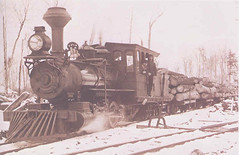The Screeching Wild Cat
Kitty Pierce, Lindley Town Historian, sent this excerpt from "Pioneer Days and Later Times in Corning and Vicinity" by Uri Mulford:
The Days of Boating and Rafting On the Rivers...Chapter XXVIII
During the period extending from the opening of the upper Chemung territory for settlement until the Erie Railroad had proven its worth, the water route to and from the seaboard was the chief dependence of the people of the Painted Post country for transportation purposes. Canoes, row-boats and flat-boats that would carry serveral tons, were much in use, both locally, and for trips to and from the seaboard or intermediate points, and for use on branch streams. As noted in a preceding chapter, arks and rafts formed of hewn four-square timbers slashed together, or composed of six to a dozen cribs of sawn lumber ingeniously lashed together, were used to carry farm products, peltry and cured venison down stream to market.
When steam boats were brought into practical use elsewhere, several heroic but futile attempts were made to use them to overcome the twists and turns and swift currents of the erratic waters of the Chemung and Susquehanna Rivers in their rush from the Genesee Country to the Chesapeake. However, so long as "lumbering" continued the chief and most profitable industry in Steuben County, N.Y. and along the Tioga and Cowanesque branches of the Chemung, rafting continued. A share of the lumber traffic was diverted by the Chemung Canal, during "canal days", being hauled to the loading docks from near-by saw-mills, or transhipped from lumber cars of the "Tioga" railroad.
This railroad for many years featured a lumber train, known as "the Wild Cat" whose screeching locomotive left Corning before daybreak each week day morning, leaving empties at various mill switches, the crew taking dinner at "Bloss", and then cars piled high with lumber were "picked up" on the return trip. That was before the telegraph had began to dictate orders to conductors, and when coupling pins and hand brakes held sway. (Our own Lindley)"Wild Cat" had absolute and supreme right of way over farm stock, track hands and any and all other trains. It was governed by no speed limit save the power of the boiler under full pressure to make the drivers "hum."
Click on the headline and it will take you to a terrific article on logging with more fantastic pictures of locomotives and the industry of lumbering from 1870 to 1890 in Michigan-- which was similar to our own Lindley history of logging.



0 Comments:
Post a Comment
<< Home